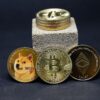
NFTs are non-fungible tokens that are not interchangeable with other NFT tokens. NFT dApps or decentralized applications are powered by blockchain for digital propriety records and innovative monetization.
The combination of NFTs and decentralized applications creates an ecosystem that empowers individual investors by introducing unique features such as the programmability of assets. In this manner, NFT DApps can offer innovative solutions for various sectors.
How do NFT DApps Work?
Decentralized applications and NFTs are byproducts of blockchain technology. At their base, NFTs and DApps have different designs and functions. However, the combination of these protocols creates a new utility for investors.
NFTs are used in decentralized applications to indicate ownership and unlock features for real and digital trading products. Decentralized applications can tokenize unique goods such as in-games assets, digitized art, and digital real-estate using NFT standardization protocols such as ERC-721 and ERC-1155.
At the same time, DeFi and Web 3.0 games can use NFTs are in-game assets to trade digital entities such as avatars, themes, features, and other options. The gamers can sell or purchase these assets on secondary marketplaces using digital currencies. In this manner, all gaming products are commoditized and have real-propriety records.
Furthermore, they can be used across multiple networks on account of technical standardization. In this manner, individual creators can have greater control over their production while removing middlemen such as music labels etc.
Types of NFT DApps
Here are types of NFT DApps:
Digital Art Galleries
Just like art galleries in real world, NFT investors can visit digital auction house and galleries dealing in NFTs. Some of these platforms are OpenSea and Rarible where investors can purchase, list, sell, and exchange their original NFTs.
On this account, digital art galleries have become an emerging trend in the art industry. They allow artists to list and sell their work directly without paying hefty trading charges.
Games and Virtual Worlds
Gaming platforms such as Decentraland and CrytoKitties are types of in-game products that investors can create and trade. This market has emerged on account of introduction of web 3.0 gaming platforms that are based on blockchains.
These DeFi gaming products have introduced concepts such as play-to-earn that allow investors earn rewards by participating in blockchain-based games.
Digital Real Estate
Digital real estate is another major use case of NFTs. In this manner, investors are able to create and invest in virtual real estate that allows them to purchase, sell, or trade virtual landscapes and properties.
There are some digital bidding houses and in other cases, the investors can purchase digital property directly from designers.
NFT Collateral and DeFi
Aavegotchi and Rarible are some of the decentralized NFT trading platforms. However, these platforms allow investors to stake NFTs as collateral to withdraw or allot cryptocurrency loans.
Minting Platforms
Minting platforms are Foundation and Mintable allow artists, musicians, and other producers to mint new NFTs. At the same time, the account holders can also list their NFTs and showcase the international audiences. These platforms are intermediaries that connect producers with buyers.
How to Launch a NFT DApp: A Step-by-Step Process
Scope
The first step to creating an NFT DApp is deciding the scope and functionality of the project. This defines goals, user base, and unique features that make the DApp standout from the competition.
Blockchain
The next step is creating an NFT DApps a suitable blockchain to host project. The blockchain should have support for NFT standard such as ERC-721 and ERC-1155.
Development Ecosystem
Once the scope and blockchain have been set, the developer should now pick the right development environment and developer tools. It can be in the form of development kits, blockchain frameworks, and programming repositories etc. These features allow investors to generate and test NFT DApps before the main launch.
Smart Contracts
Smart contracts manage propriety, minting, purchasing, transfer, trading, selling, and distribution for NFTs. Therefore, the developers have to create a suitable smart contract that aligns with the project scope.
Wallet Integration
Integrate wallet allows investors to send NFTs among various decentralized protocols using digital wallets.
Minting Functionality
The user interface (UI) of an NFT DApp should include features such as minting and tokenization.
Conclusion
Decentralized Applications for NFTs bring a lot of utility. However, investors should also have limitations such as scalability, transaction complexity, and network congestion.










